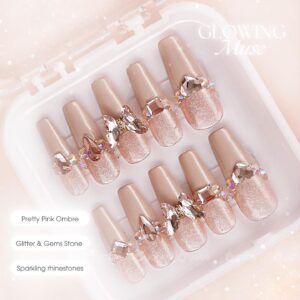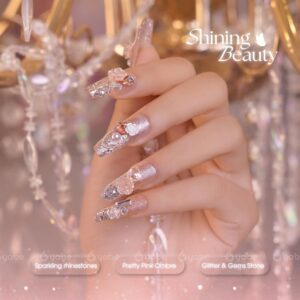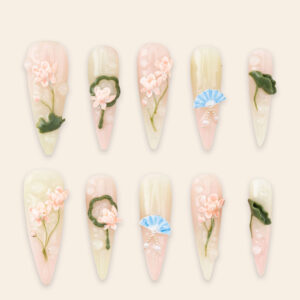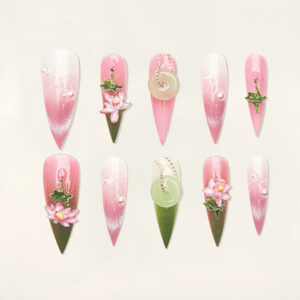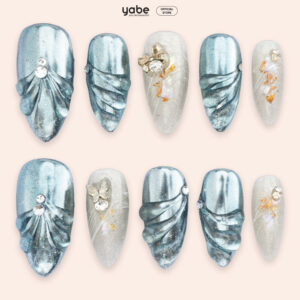What are press on nails? Why have they become a game-changer in the beauty industry? They offer a quick and affordable alternative to salon manicures. These artificial nails come in various shapes, sizes, and designs, making achieving a salon-quality manicure at home easy. But what are press-on nails, and how do they work?
This comprehensive guide explores everything you need to know about press-on nails, from their history and benefits to application techniques and maintenance tips.

What are Press on Nails?
Press on nails are artificial enhancements designed to be glued or adhered to the natural nail for an instant manicure. They are made from materials like acrylic, gel, or plastic and come in various designs, lengths, and finishes. Unlike acrylic or gel nails, press-on nails do not require professional application or long-term commitment.
Brief History
Press on nails were introduced in the 1980s as an easy, temporary solution for those looking to enhance their nails without the hassle of a salon visit. Over the years, materials and adhesive technology advancementshave made them more durable and natural-looking.
Press on Nails vs. Acrylics vs. Gel Nails
| Feature | Press-on Nails | Acrylic Nails | Gel Nails |
|---|---|---|---|
| Application Time | 5–10 minutes | 1–2 hours | 1–2 hours |
| Durability | 1–2 weeks | 3–4 weeks | 2–3 weeks |
| Harm to Natural Nails | Minimal | Can cause thinning | Can weaken nails |
| Cost | $10–$30 | $50–$100 | $40–$80 |
How Do Press on Nails Work?
Press on nails adhere to the natural nail using either nail glue or adhesive tabs. The choice of adhesive determines how long the nails last and how easy they are to remove.
Types of Adhesives:
- Nail Glue – Provides a strong bond lasting up to two weeks.
- Adhesive Tabs – A temporary option that allows easy removal within a few days.
Types of Press on Nails
Press on nails come in a variety of shapes, sizes, and materials to suit different preferences.
By Material:
- Plastic Press-ons – Affordable and lightweight.
- Acrylic Press-ons – More durable and salon-quality.
- Gel Press-ons – Have a glossy, natural-looking finish.
By Shape:
- Square
- Coffin/Ballerina
- Almond
- Stiletto
- Round
By Finish:
- Glossy
- Matte
- Glitter
- French tip
- Embellished (gems, rhinestones, nail art)
Benefits of Using Press-on Nails
- Affordable – A fraction of the cost of salon acrylics.
- Easy to Apply – No professional skills required.
- Customizable – Available in endless designs.
- Damage-Free – Less damaging than acrylic or gel nails.
- Time-Saving – Instant manicure in minutes.
How to Apply Press on Nails?

Step-by-Step Guide:
- Prep Your Nails – Clean, file, and buff your natural nails.
- Choose the Right Size – Match each press-on nail to your nail size.
- Apply Adhesive – Use nail glue or adhesive tabs.
- Attach the Press-on Nail – Press firmly for 30 seconds.
- Shape and File – Adjust the length or shape if needed.
How to Remove Press on Nails?

To prevent damage to natural nails, use these safe removal methods:
- Soak in Warm Soapy Water – Helps loosen the adhesive.
- Use Cuticle Oil – Gently lifts the press-on nails.
- Acetone Soak – For nail glue-based press-ons.
How Long Do Press on Nails Last?
- With Nail Glue: 7–14 days
- With Adhesive Tabs: 3–5 days

FAQs About Press-on Nails
1. Can I shower with press-on nails?
Yes, but excessive water exposure can weaken the adhesive.
2. Can I apply polish to press-on nails?
Absolutely! Use regular or gel polish to customize your look.
3. Are press-on nails safe for kids?
Yes, but opt for non-toxic, child-friendly versions.
4. How do I remove nail glue residue?
Use acetone or an oil-based remover.
5. Do press-on nails work on short nails?
Yes, as long as the adhesive properly sticks to the nail surface.
6. Can I cut and file press-on nails?
Yes! Shape them however you like.
Conclusion
Press on nails are a fantastic, budget-friendly alternative to salon manicures. With endless styles, easy application, and minimal damage, they are perfect for anyone looking to switch up their nail game quickly and effortlessly.

